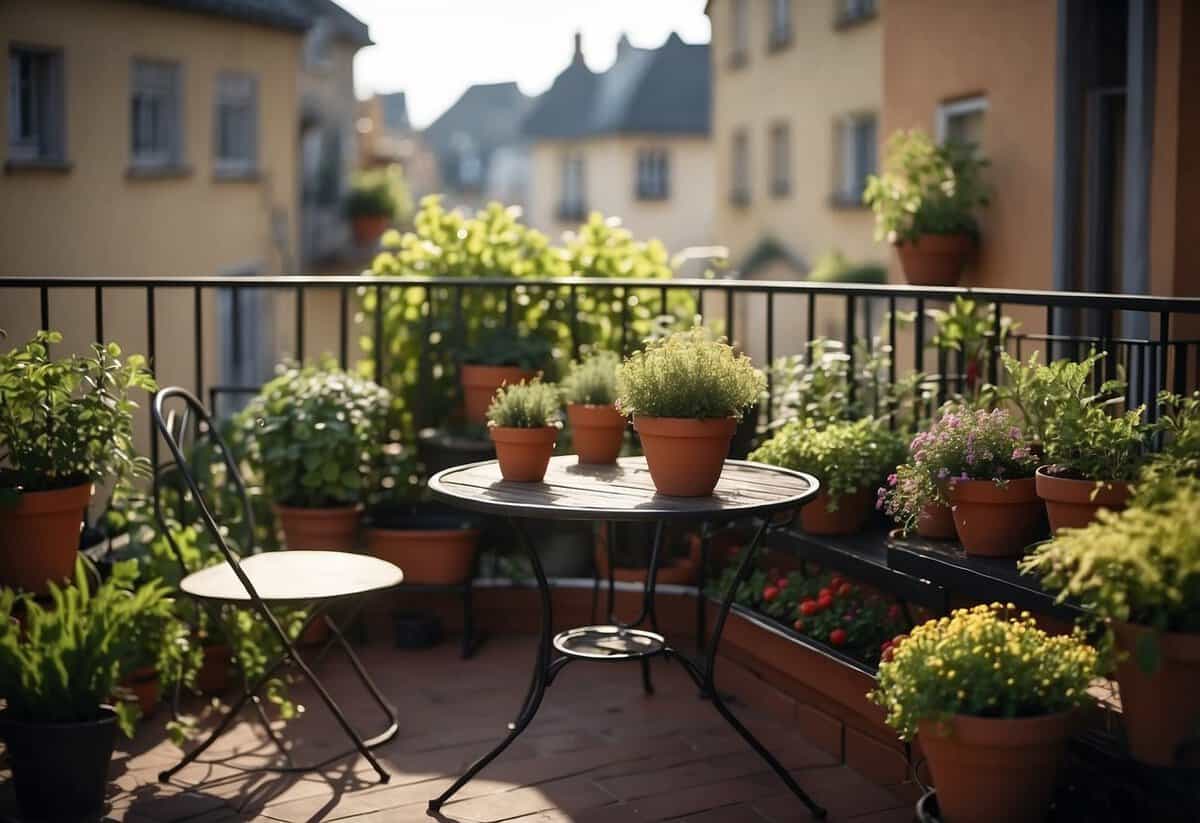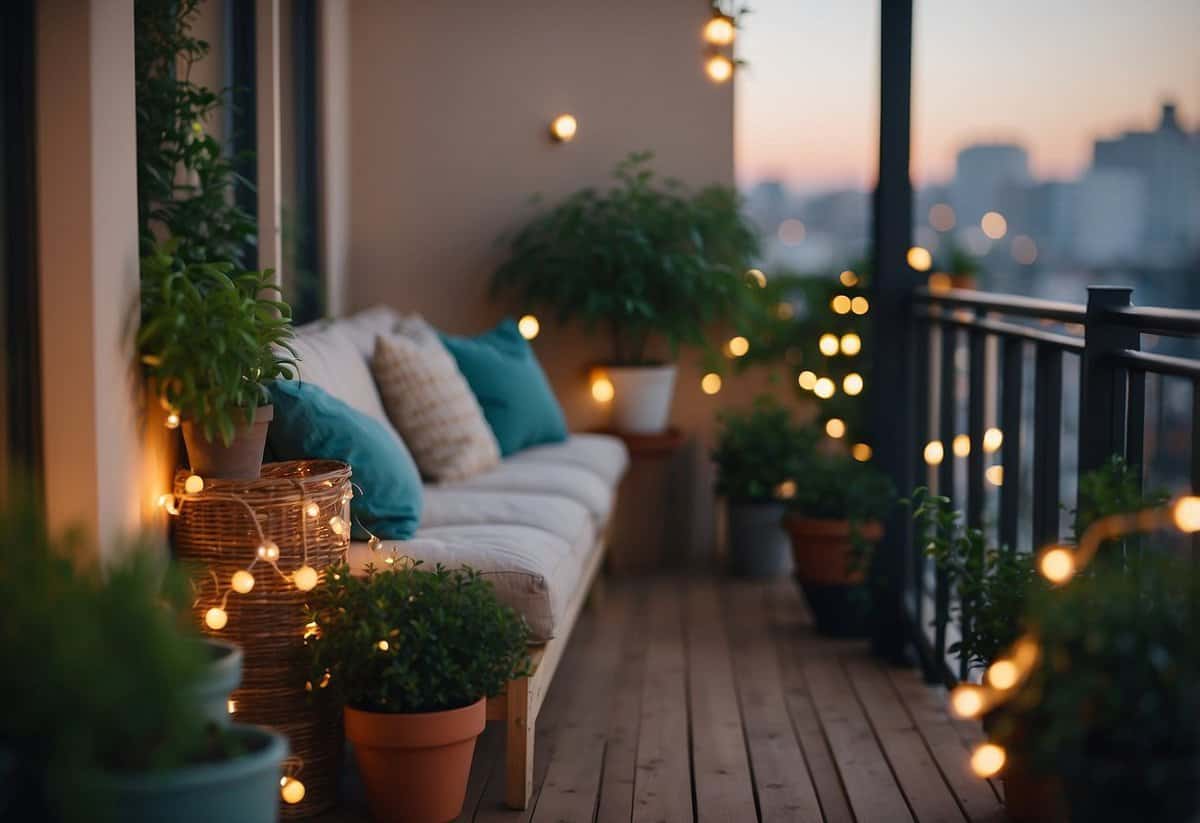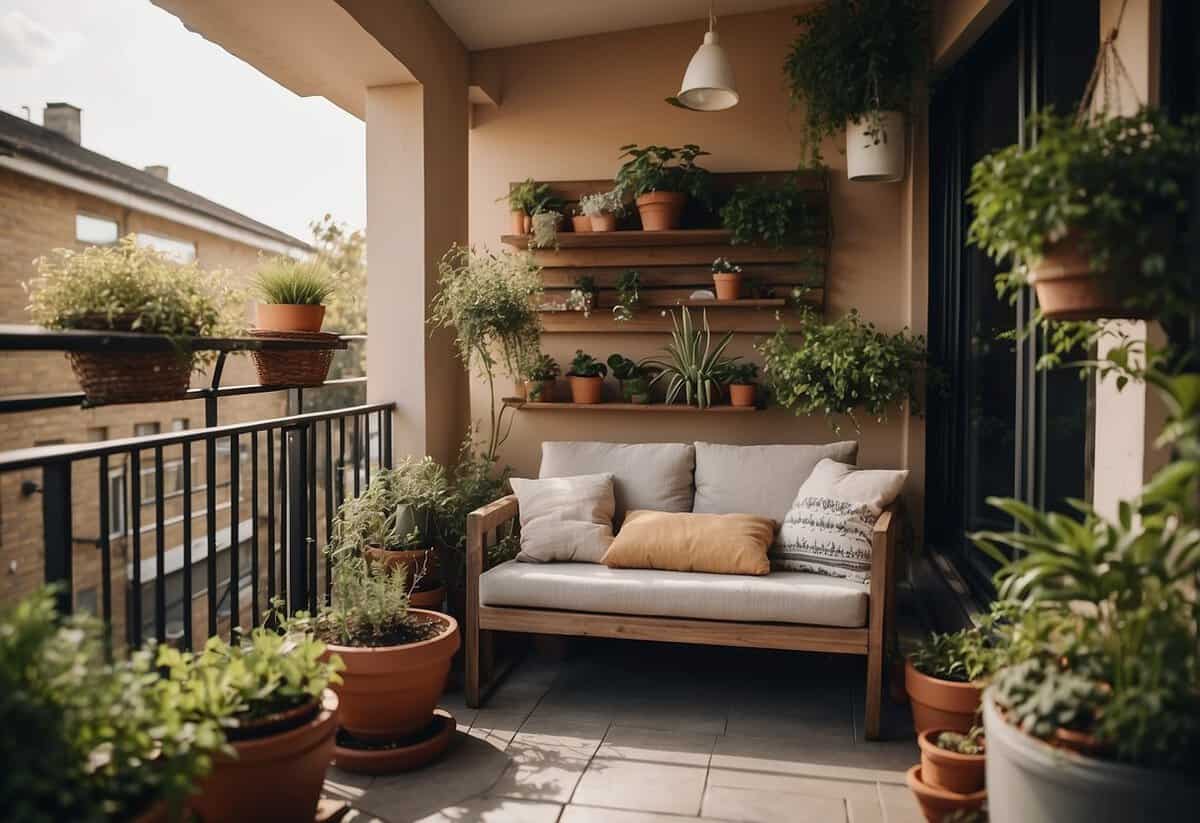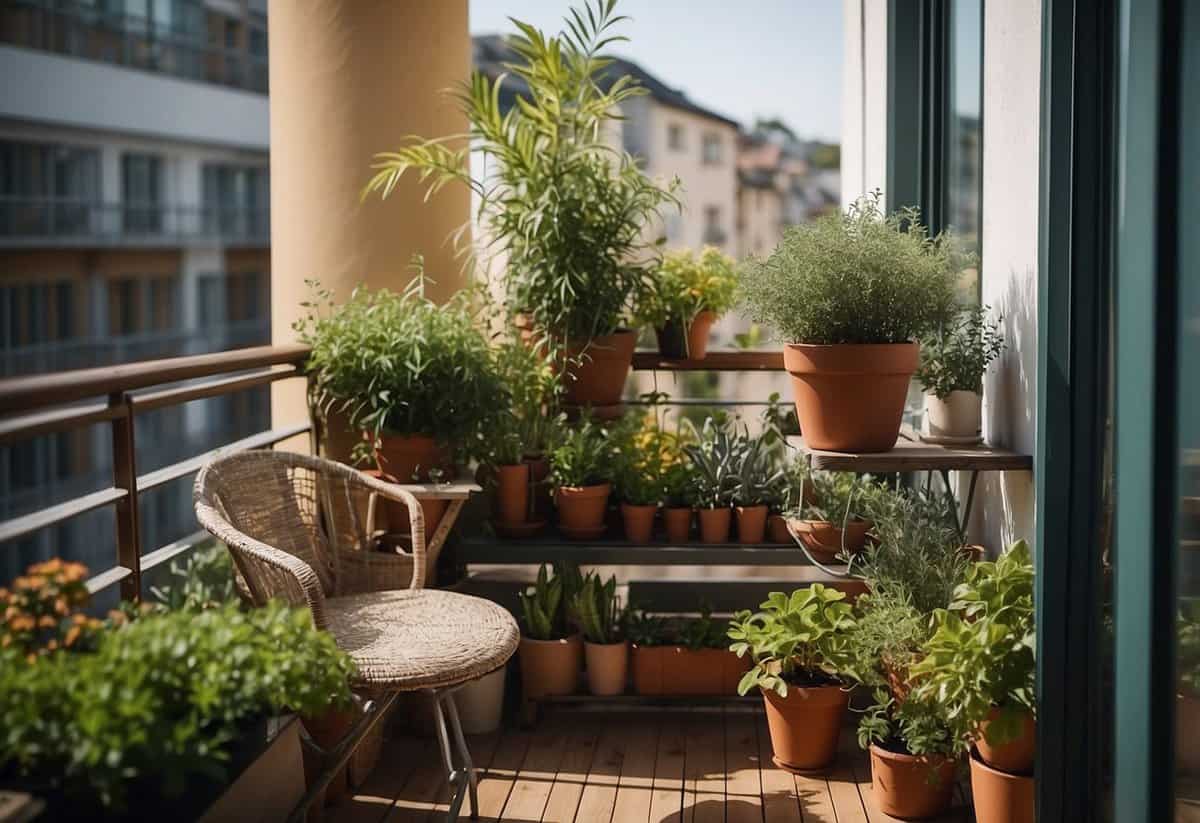Balcony Garden Ideas: Transform Your Outdoor Space
Creating a garden on your balcony can transform your outdoor space into a cozy retreat. Whether you live in an apartment or a small house, a balcony garden offers a touch of nature and a breath of fresh air right outside your door.

Imagine stepping out to admire colorful flowers or pick fresh herbs for your meals. With the right ideas, you can design a vibrant and functional garden in even the smallest of spaces. Use pots, shelves, or hanging baskets to make the most of your balcony and bring your gardening dreams to life.
1) Vertical Planting

Vertical planting is a great way to use your balcony space efficiently. You can grow a wide variety of plants and also create a beautiful green wall.
One classic idea is the vertical bottle planters which are easy to make and great for herbs.
Another option is using a strawberry tower garden which can be placed in a sunny corner for growing trailing plants.
Always make sure to regularly water and check for pests to keep your vertical garden thriving.
2) Rail Planters

Rail planters are a great way to add greenery to your balcony without taking up floor space. They attach directly to your railing, keeping your plants elevated and easily accessible.
One popular option includes geraniums, which are low-maintenance and colorful.
For more variety, you can try strawberries. They cascade beautifully and provide delicious fruit.
When choosing a rail planter, look for adjustable options like the Apollo Exports International model. This ensures a good fit for different railing sizes.
3) Herb Garden

Starting a herb garden on your balcony is a great idea. You can grow flavorful plants like basil, rosemary, and mint. These herbs are easy to grow and maintain.
Use small pots to save space. Herbs like rosemary, in particular, grow well in small containers. Make sure your pots have drainage holes to prevent overwatering.
During summer, herbs might need daily watering. In fall or winter, you can water less frequently. Check if the soil is dry by picking up the pot or sticking your finger into the soil.
4) String Lights

Adding string lights to your balcony garden can create a cozy and inviting atmosphere.
Try the popular maypole design where lights radiate from a central pole. This adds a festive look.
Hanging lights along your balcony railings can also be quite charming. It’s a simple and effective way to brighten up your space.
For a creative touch, consider weaving the lights through potted plants. This adds a magical, glowing effect as the lights peek through the leaves. You can also line a nearby fence with string lights to bring warmth and light to your garden.
5) Compact Furniture

When designing a balcony garden, choosing the right furniture is key. Compact furniture helps maximize your space while providing comfort and style.
Look for folding chairs and tables that can be easily stored when not in use. Stackable furniture is also a great option for small balconies.
Consider lightweight designs that are easy to move around. These allow you to rearrange your balcony as needed, making it a versatile outdoor space.
6) Hanging Baskets

Hanging baskets are a great way to add beauty to your balcony. They don’t take up floor space and come in various styles.
You can create a colorful contrast using different plants or go for a neat look with similar shades. Begonias, for example, are perfect for shady spots.
For a touch of patriotism, consider combining red, white, and blue flowers. Suspended hanging planters can give your balcony a unique look by hanging pots on the outside.
7) Privacy Screens

Adding a privacy screen to your balcony garden is a great way to create a secluded space.
You can choose from many types of privacy screens. Some popular options include wooden lattices, metal panels, and fabric screens.
A rail planter is a smart choice because it doubles as a planter and a screen, adding greenery while ensuring privacy.
8) Foldable Table

A foldable table is a great addition to your balcony garden. It offers flexibility and can be stowed away when not in use. This helps maximize space for plants or other furniture.
You can find stylish folding balcony tables that match your decor. Some even come with options for off-the-floor storage. Whether it’s for dining or displaying plants, a foldable table is a practical choice.
9) Succulent Collection

Transform your balcony into a relaxing oasis with a succulent collection. Succulents are low-maintenance and come in various shapes and colors.
Use tin planters for pink echeverias or arrange aeoniums along the railing. Install a plant stand to display different varieties.
Create unique displays by using unusual items like cookie tins or vintage radios. These creative ideas will add charm and personality to your outdoor space.
10) DIY Pallet Garden

A DIY pallet garden is a fantastic way to add greenery to your balcony. You can repurpose wooden pallets into vertical gardens that make the most of your space.
Start by securing small pots or fabric pockets to the slats. This setup is perfect for herbs and small plants.
You can also create a stunning display with succulent frames. These are easy to maintain and look beautiful year-round.
Adding a few planters with flowers will brighten your balcony and make it a relaxing place to spend time.
Choosing The Right Plants

Picking the right plants for your balcony garden can greatly affect its success. Focus on the specific needs of each plant, including sunlight requirements and climate considerations.
Sunlight Requirements
Different plants need varying amounts of sunlight. Some thrive in full sun, while others prefer shade. Caladiums, for example, need part shade to shade, making them ideal for less sunny spots. If your balcony gets plenty of sunlight, consider plants like succulents or herbs such as basil and thyme.
Create a sunny vs. shady area on your balcony to accommodate different plant needs. For instance, if it’s sunny, place drought-tolerant plants like lavender and rosemary. In shady areas, grow ferns or hostas. Use this approach to ensure all plants get their needed light.
Climate Considerations
Consider your local climate since it affects what plants can thrive. If you live in a cooler area, choose hardy plants that can tolerate lower temperatures, such as pansies or snapdragons. In warmer climates, opt for heat-tolerant plants like bougainvillea or hibiscus.
Seasonal changes also play a role. In winter, protect tender plants from frost by using covers or bringing them indoors. During summer, ensure frequent watering to prevent wilting. Take time to study your climate patterns and choose plants accordingly to enjoy a thriving balcony garden.
Adding plants also creates a cozy, relaxing environment. Incorporate accessories like string lights for ambiance and small garden furniture for enjoying the space.
Maximizing Small Spaces

When you have a limited balcony space, using vertical and container gardening methods can help you make the most of it. These techniques allow you to grow more plants without taking up too much room.
Vertical Gardening
Vertical gardening makes great use of available space by growing plants upwards. You can use tiered planters, trellises, or hanging baskets to create a lush wall of greenery.
One popular idea is to install wall-mounted planters or shelves. These allow you to grow a variety of plants without cluttering the balcony floor. Climbing plants, like ivy or jasmine, can add privacy and charm.
Additionally, consider using a ladder shelf. This multi-tiered piece of furniture provides levels for different plants. It’s an efficient way to display your greenery beautifully. You can find more ideas on balcony gardening.
Container Gardening
Container gardening involves using pots and planters to grow your plants. Choose containers that fit well in your space. Small and medium-sized pots are ideal for herbs and flowers.
Think about using stackable pots or a garden tower. These allow you to grow multiple plants in one spot. Containers can also be placed on plant racks, saving floor space.
Use lightweight materials for easy relocation. This flexibility helps you move plants to catch the sun. It’s important to select plants that match your lighting conditions. Learn more tips from this small balcony gardening guide.
Maintenance Tips

To keep your balcony garden thriving, it’s essential to focus on regular watering and effective pest control. Paying attention to these key areas can make a big difference in the health and appearance of your plants.
Watering Schedules
Watering your plants properly is crucial. Different plants need different amounts of water. Succulents and cacti need less water because they store water in their leaves. Plants like herbs and veggies need more frequent watering, especially during hot weather.
Morning is the best time to water. This helps prevent leaf diseases that can occur if plants stay wet overnight. Using a watering can is often easier for small spaces compared to a hose.
Consider investing in water-saving granules to extend the time between waterings. These can be mixed into the soil and help retain moisture, keeping your plants hydrated for longer periods.
Pest Control
Pest control is another essential part of maintaining your balcony garden. Aphids, spider mites, and whiteflies are common pests that can harm your plants. Regular inspection of your plants can help you catch these pests early.
Using natural remedies like neem oil can be effective. Mixing water and dish soap and spraying it on the plants can also deter pests without harming your plants. Introducing beneficial insects like ladybugs can help keep pest populations under control.
Keep your garden clean. Remove fallen leaves and dead plants as these can attract pests. Rotating your plants can also help prevent pest infestations by confusing the pests.







